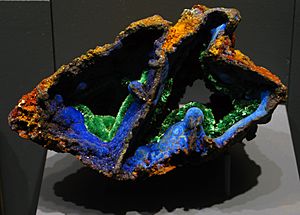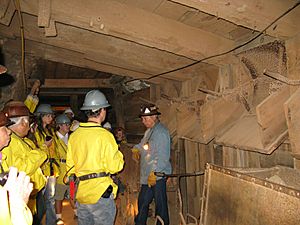Copper Queen Mine facts for kids

The Copper Queen Mine was a very important copper mine located in Cochise County, Arizona, United States. It helped the nearby town of Bisbee grow a lot in the 1880s. The mine was special because its copper ore was super rich, with about 23% copper! A big company called Phelps Dodge bought the mine in 1885.
In the early 1900s, the Copper Queen Mine was the busiest copper mine in all of Arizona. Even though copper mining slowed down in the area during the 1930s and 1940s, the Copper Queen kept going. After World War II, it started using a method called open-pit mining. But as it became harder to find enough copper, Phelps Dodge finally closed the mine in 1985.
The Mine's Story
People might have known about copper in the Mule Mountains of Arizona as early as 1876. But the first official mining claim was made on August 2, 1877. That year, a group of U.S. Cavalry soldiers from Fort Bowie were looking for Apache Indians. They camped at a place later called Iron Springs. The water wasn't good, so they sent a scout named Jack Dunn to find better water.
During his search, Jack Dunn found a spring near a huge limestone cliff, which became known as Castle Rock. On his way back, he also saw rocks that contained lead carbonate, which often meant silver was nearby. This was in a place later called Tombstone Canyon. Dunn told his officer, Lt. John Rucker, and a packer named Ted Byrne about his discovery. They wanted to claim the spot, but they had to leave to chase the Apache warriors. Before they left, they met a man named George Warren. They asked him to file the claim for them, promising to share the discovery. They gave him supplies and a map.
However, George Warren did not keep his promise. On his way to file the claim, he stopped at a saloon. He lost the supplies and money given to him in a bet. He then went to Fort Huachuca and found new people to help him from Tombstone. On September 27, 1877, Warren filed a claim for the Mercy Mine. This was 56 days after Dunn first found the spot. Over the next six months, Warren helped claim several other mines in the area, creating what was called the Warren Mining District. He owned a small part of the new Copper Queen Mine.
Later, while having fun with friends, Warren made a bet that he could outrun a man on a horse. He lost the bet and, sadly, lost his share in the Copper Queen Mine. This share was later thought to be worth a lot of money.
How the Mine Grew
In 1880, two businessmen, Edward Reilly and Levi Zeckendorf, had a chance to buy the mine. When tests showed the ore had 22% copper, Reilly became very excited. He bought out other people's shares in April 1880. He then went to San Francisco to find investors. Reilly convinced engineers DeWitt Bisbee, William H. Martin, and John Ballard to visit the mine. They were very impressed. On May 12, 1880, Martin and Ballard agreed to provide money to mine the ore. They received a large share of the Copper Queen mine.
James Douglas from Pennsylvania had invented new ways to melt copper. He learned about the Warren mining district early on. The Phelps Dodge company from New York City sent him to check out possible copper mines. Douglas thought it was a big risk, but he convinced the company to go ahead. He chose to get a 10% share of the mine instead of a one-time payment, which later made him very rich.
Phelps Dodge bought another mine nearby, the Atlanta Mine. They spent a lot of money exploring before they found the main copper deposit. To avoid arguments over land, Phelps Dodge joined with the Copper Queen mine in 1885. They formed the Copper Queen Consolidated Mining Company.
At first, the easy-to-reach copper on the surface was quickly used up. But the owners found that the deeper ore was incredibly rich, with 23% copper. It also had silver and gold as extra valuable materials. Most mines back then could only make money from ore with 8% to 10% copper. So, the Copper Queen's ore was considered amazing. After a few years, the surface ore was gone, but miners dug deeper and found even bigger deposits.
In the early 1900s, the Copper Queen was known as the most productive copper mine in Arizona. Many people thought it was the best-run copper mine in the United States.
Challenges and Changes
Mining work was very dangerous. The Phelps Dodge company sometimes asked miners to work without pay. They also used unfair and unsafe practices, like blasting explosives while miners were still in the mine. There were also claims that non-white miners were treated unfairly.
In 1917, miners formed a union. The mine became the site of a strike by the Industrial Workers of the World miners' union. Phelps Dodge did not want unions. They used private police to arrest more than 1300 miners. These miners were put on railroad cars and sent away from the town and area. This event became known as the Bisbee Deportation.
Before engines were used, mules helped transport ore cars out of the mines. These mules were trained to pull heavy cars that weighed over 2800 pounds. The mules lived inside the mines all the time, sleeping in special stables. They would work in the mines for about four years. After that, their eyesight would get worse because of the darkness. To help them get used to daylight again, blinders with small holes were put over their eyes. The holes were slowly made bigger as the mules' eyes adjusted to the light.
In the 1950s, Phelps Dodge started using open-pit mining at the Copper Queen. This allowed mining to continue. Some underground work was still done too. By the mid-1960s, the amount of copper in the ore from the Copper Queen had dropped to 4%. The mine stopped producing copper in 1975.
The mayor of Bisbee and volunteers wanted to find new ways for the town to make money. They suggested that part of the mine could be opened for tours. Phelps Dodge agreed. Workers and volunteers fixed up the area to create a place for visitors to learn about the mine's history. More than one million people have visited the mine since it reopened for tours in 1976. The old Phelps Dodge headquarters building in Bisbee is now a mining museum. It teaches visitors about the mining era and its impact on the region.
The company was later bought by Freeport McMoRan. In the early 2000s, this new company was looking into new ways to mine in the area.
More to Explore
- Bisbee Massacre
- Copper mining in Arizona
- Courtland, Arizona
- Lavender Pit



